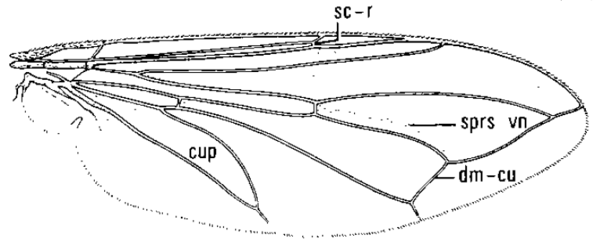Numbers
2 genera in our area:
Physocephala and
Physoconops (1)(2). Many other genera occur from Mexico south into South America, and elsewhere worldwide.
In our area (North America, north of Mexico):
Physocephala has
7 species; and
Physoconops has 13 species (12 are listed
here and in Stone
(2); the 13th,
Physoconops weemsi, was described in 2007
(3)).
Identification
Physocephala and
Physoconops closely resemble each other and are often confused. They can usually be distinguished by examining the
wing venation and the shape of the
hind femora.
Wing Venation In Physocephala, the anterior crossvein (denoted "r-m" in the diagram below), is located well beyond the middle of discal cell (denoted "dm"); and the discal cell is strongly "indented" just basad of the crossvien r-m. Note that the tiny crossvein bounding the discal cell at its base is usually hard to see, but it is always just beyond where the vein on the lower edge of the discal cell meets cell "cup" (cf. 2nd diagram below):
In Physoconops, the crossvein r-m is near or before the middle of cell dm; and the discal cell is typically less strongly indented basad of crossvein r-m, and often more-or-less straight along its upper edge:
One last, subtle wing venation character: In Physoconops, the crossvein r-m is closely aligned with the (often hard to discern) crossvein "sc-r", near where the subcosta meets the leading edge of the wing; whereas in Physocephala the crossvein "sc-r" occurs significantly basad of crossvein r-m. Check if you can see this character, by first examining the wing venation diagrams above, and then the representative photos.
Hind femora In Physocephala the the hind femur is irregularly thickened and widest in its basal portion:
In Physoconops, the hind femur has a more uniform thickness and is widest near the middle:
Note that the hind femur character is best employed with a profile view. From some angles the basal swelling in Physocephala may not be clearly apparent.
To be confident of an identification, it's best to have a number of characters available for verification, since some may be difficult to see and/or interpret (and sometimes may not even "work", due to variation). While the above characters are the primary ones used to separate Physocephala and Physoconops in most keys, and are presumably the most consistent and dependable ones, the following additional characters are also useful in distinguishing the two genera:
1) Physocephala do not have ocelli, whereas Physoconops have very small ocelli located on a swelling at the vertex(1) [see comment here by Jeff Skevington]. 2) Nearly all Physocephala have a sharply defined "T"-shaped marking on the frons, whereas only one uncommon species on Physoconops does in our area (P. nigrimanus). 3) In Physoconops the last few tarsi on all legs are typically dark black and the pulvilli are large and light yellow; whereas in Physocephala the tarsi are typically narrower, lighter reddish or yellowish, and the pulvilli and darker (with little or no yellow) and typically smaller. 4) In many (but not all!) Physoconops the 3rd antennal segment is noticeably much longer than it is in Physocephala. 5) In many (but not all!) Physoconops the female's theca (see thumbnail below) is noticeably much longer than it is in Physocephala: 
Male vs. FemaleMales and females both have eyes equally well-separated in Conopinae...females in the subfamily are distinguished by the presence of a theca beneath the 4th & 5th sternites, and also a "blocky", somewhat "hooked" terminal abdominal segment...see the 3rd & 4th bulleted items here. See Also
A small group of genera in Syrphidae (tribe
Cerioidini) are often mistaken for Conopinae. Cerioidini differ in possessing a(n often conspicuously long)
frontal prominence; and a subtly different wing venation pattern:
Conopinae

Cerioidini

Also, in Conopinae the proboscis (= prolonged portion of the mouthparts) always extends conspicuously beyond the oral cavity and is long, narrow, and stiffly straight; while in Cerioidini the stem of the proboscis is wider and is tipped by a bulbous, sponge-like labellum...and it is typically held hidden within the oral cavity when a cerioidine is at rest (i.e. not lapping nectar or honey-dew, etc.):
Another useful distinction is that, in Conopinae, both sexes always have their eyes well-separated...whereas males of Cerioidini have their eyes touching on the top of their head (for at least a short distance, often longer). So if you're thinking you have a conopine but notice it has "eyes touching", consider Cerioidini. (Of course, this only helps for males.)
Print References
See Print References listed for
Physocephala and
Physoconops.































